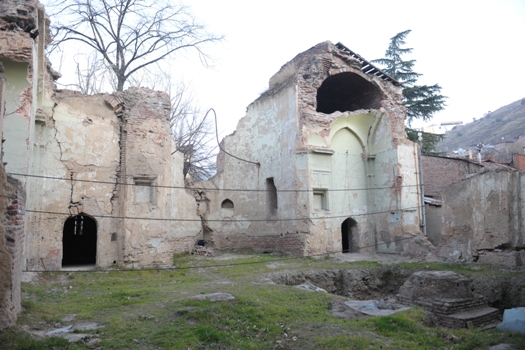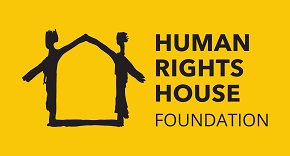Natia Gogolashvili
Nowadays, there are several temples in Tbilisi, which are topic of controversy between the Georgian Orthodox Church and Armenian Apostolic Church. They are: Norasheni Church of Dormition of the Mother of God, Surb Nishani, Mognisi St. George Church, Surb Mina and Shamkaretsi. Nowadays all these temples are on the edge of collapse. All five temples have status of the cultural heritage. Today, only Norsheni Church is being reconstructed.
Surb Nishani Church is considered to be the most ancient among the aforementioned five churches; it was built in 1703-1720. During soviet time book depository of the national public library was functioning in it; the fire destroyed the depository several years ago. For some time, dog shelter also functioned in the church, for what the interior is polluted.
In 2011, the Georgian National Agency for the Preservation of Cultural Heritage announced a competition, which was won by the ICOMOS Georgia; the latter drafted full rehabilitation project for the Surb Nishani Church, according to which a new bid was announced for the reconstruction and Ltd Constructor 2012 won it; the company performed part of building reinforcement works that stopped collapse of the northern part of the interior. Afterwards, the works stopped because the Tbilisi City Hall could not evict a citizen, living in the house next to the church. The citizen has a dog shelter in the yard of the church for what there is constant unhygienic situation and noise in the area.
Moghnisi St. George Church was constructed in 1751. On November 19, 2009 the dome and big part of the walls of the demolished building collapsed. Tbilisi City Hall services promptly cleaned the surrounding area from ruins and afterwards in 2010 Ltd Architex, which won the competition announced by the National Agency for the Preservation of Cultural Heritage, implemented rehabilitation works in the church. The company installed iron belts over the building to hinder collapse of the eastern part of it.
“After soviet regime was established in Georgia, Moghnisi St. George Church stopped functioning. In the soviet time the temple was used as part of ethnographic museum. Afterwards it was abandoned and started falling down. We addressed the authorities during Shevardnadze and Saakashvili’s presidencies and requested them to assign the church to us but in vain. As a result of negligence the dome fell down in the autumn of 2009. Recently we addressed the State Agency for Religious Issues to return the church to its historical owner,” Mikheil Avakyan, head of the Office for Legal Issues and Cooperation at the Armenian Diocese.
Norasheni Church of the Dormition of the Mother of God was constructed on the place of an old church, which was destroyed by the invasion of Āghā Moḥammad Khān after 1796. In 1925, the soviet government wanted to destroy the church but resistance of Tbilisi population saved it from deconstruction and finally the building was assigned to the library of the Georgian Academy of Science.
In 2014, National Agency for the Preservation of Cultural Heritage announced a bid competition and Ltd Engineer Opinion won it; the Ltd prepared full project documentation for the rehabilitation of Norasheni Church. In September 2014, Ltd Aba Group started rehabilitation works in the church, which still undergo with financial support of the Foundation for the Preservation of Georgian Historical Monuments.
“The church was much damaged - walls were cracked and stones fallen. We decided to preserve the church, which is cultural heritage, from complete deconstruction. The rehabilitation works were funded by the Cartu Foundation. The project was prepared by the National Agency for the Preservation of the Cultural Heritage. The restoration started in 2014 and still continues. When workers dug the yard, they found terrible situation – the surface was not solid and it could damage the construction. So, we had to install piles and iron-concrete belt all around the church. Now we commenced second stage of rehabilitation – reconstruction of the façade,” director of the Ltd Aba Group Tamaz Abuladze said.
“We have nothing to argue about Norasheni Church because historically it was constructed by Armenians. Besides that, before soviet regime, Armenian clergies conducted liturgy in it. This church is very valuable for us,” Mikheil Avakyan said.
God Mother’s Church of Shamkori, same as Karmir Avetarani (Red Gospel) was constructed by the Armenians exiled from Shamkori in 1840s. In 1937, the soviet authority closed it down and used it initially for a bakery and then for a warehouse. The earthquake of April 13, 1989 significantly destroyed the church. The survived ornaments (seven piles) were take to the yard of Avlabari Echmiadzin Church and are still there.
“God Mother’s Church of Shamkori was the tallest church in Tbilisi but now it is in poor conditions. We first petitioned to the government in 1990s and still urge the authority to return the church to us. Then we will take responsibility to preserve it. In the past, their motive of refusal was that the diocese did not have a status but since 2011 we have the status – we are public law legal entity but still cannot get the church back,” Mikheil Avakyan said.
IDPs live in the yard of Surb Mina Church, who said the Ministry of Georgia for IDPs, Accommodation and Refugees allocated the space on them. One of them privatized the basement of the church and arranged a cellar in it. The locals said if the state takes adequate measures, they are ready to leave the vicinity of the church.
Secretary of the Georgian Patriarchate Father Michael Botkoveli said, Armenian diocese has unrealistic claims about churches. “Roots of our historical problems lay in the certain period of time when Armenians used to purchase temples in Tbilisi. How can over 600 churches be Armenian in Georgia?! They claim that they have so many churches and for that reason it is very difficult to dialogue with them. They have very unrealistic claims. Their requirements about ownership of churches in Georgia are beyond all critics. We try to continue dialogue and be constructive. Although the process is painful, I see its necessity. I do not know when we have results but the dialogue and cooperation gives us opportunity of peaceful life. These topics are so sensitive, decision-making process is so complicated that it is impossible to resolve all these problems promptly and in short time.”
Head of Legal Maintenance Office at the State Agency for Religious Issues Archil Metreveli said Armenian Apostolic Diocese has applied to the State Agency for Religious Issues with regard to 442 chapels. “Currently, priority is given to those buildings, which may be resolved more easily. The situation about disputed churches is almost similar. Big part of churches now belongs to the Orthodox Church and they already use them. It is significant that we already started consultations about this issue with relevant state institutions and bodies, like Ministry of Culture and Monument Protection and State Agency for the Preservation of Cultural Heritage. The process will continue in similar format because on the one hand it is topic of inter-religious controversy and on the other hand it is issue of cultural heritage because there are plenty of buildings on the list, which have status of cultural heritage and when studying their cases, all legal procedures shall be followed. It could be most comfortable for the state if religious confessions had reached concusses and state had the least role in it,” said Archil Metreveli.
It is noteworthy that until the disputes about the places of worship are resolved, the cultural heritage monuments are falling down. The state does not take real steps to hinder the process. Director General of the National Agency for the Preservation of Cultural Heritage Nikoloz Antidze said it would be much better if concrete persons and organizations were users of the cultural heritage.
“It is really important that the heritage had legal user, who will have responsibility and obligation to take care of it with the support of the state. For me personally, it is much better if the heritage had concrete persons and organizations as legal users. Otherwise, the state remains alone against huge cultural heritage whose preservation cannot be afforded with the state budget. The State, for sure, spend money on the preservation of heritage but mostly the state should support the owner to correctly rehabilitate the heritage and be good user,” Nikoloz Antidze said.
According to Antidze, their purpose is to preserve the monuments of cultural heritage and the dispute between different confessions shall not impact the conditions of the monuments.
The article was prepared in the frame of the project implemented with financial support of the Government of Canada. This article does not necessarily reflect the views of the donor.
Human Rights Center bears sole responsibility for the content of the article.
News
December 13, 2023
Ethnic minorities outside the peace dialogue
November 6, 2023
‘Peace’ agenda of political parties
Popular
Articles
February 13, 2024




